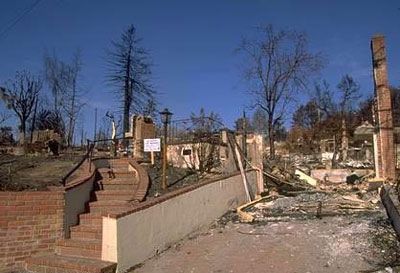Oakland Hills fire prompted changes in building laws
Fighting the wildfire was hampered by steep and narrow roads, houses with wood-shingle roofs, a restricted water supply, and fire hydrants that were incompatible with neighboring cities’ trucks. The wildfire, which burned for almost 72 hours, took 25 lives, devastated over a thousand acres of land, and destroyed more than 3,500 homes.
Oakland now requires all new Oakland Hills houses to have fire-resistant roofs, which include slate, clay, concrete roof tile or steel shingles, according to the Builders Wildfire Mitigation Guide, published by the UC Division of Agriculture and Natural Resources.
“These materials are more accessible now than in 1991,” said Steve Quarles, a researcher at the Insurance Institute for Business and Home Safety, a Florida-based organization that conducts studies on natural disasters aimed to reduce human and financial loss. Quarles retired from UC Cooperative Extension Aug. 1 after serving for 26 years as a wood durability advisor. “Probably most of them were available at that time, but now they are less expensive and people can acquire more information about them.”
How to decipher nutrition labels
Claudia Mosby, The Redding Record-Searchlight
A heart-healthy, sugar-free or low-fat label on your favorite box of crackers at the store doesn't automatically mean it's a healthy food item. These eye-catching labels draw attention to what may be a healthier choice, but to accurately assess the item's nutritional value you need to read and understand its nutrition facts label.
According to Concepcion Mendoza, nutrition family and consumer science advisor at University of California Cooperative Extension in Shasta and Trinity counties, nutrition facts labels became mandatory in the early 1990s. These labels list the number of calories, fat grams and nutrients per serving for a food item, along with its percent of daily value recommendation.

